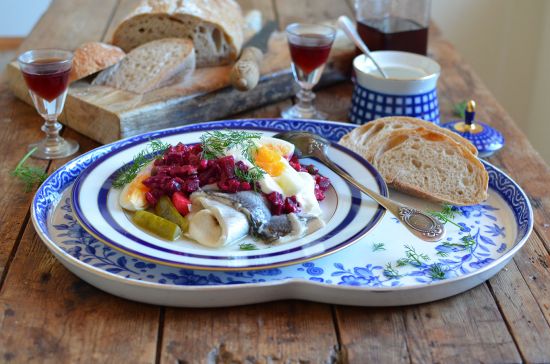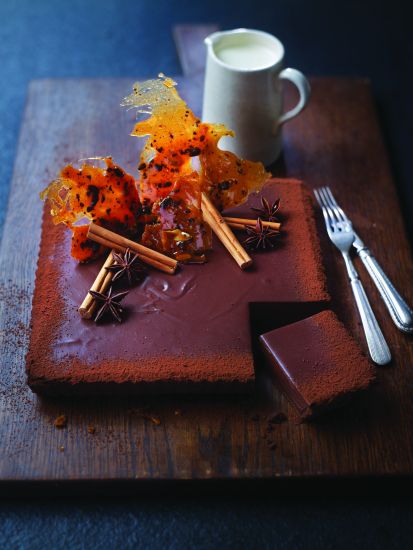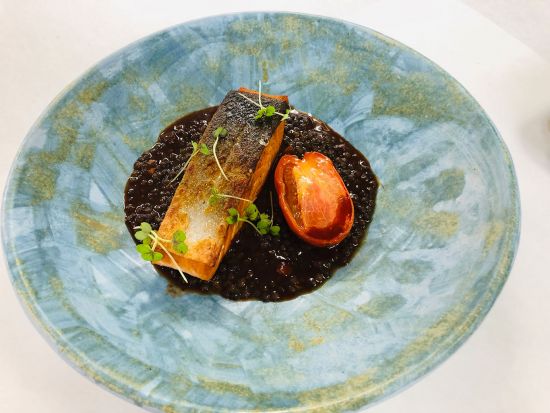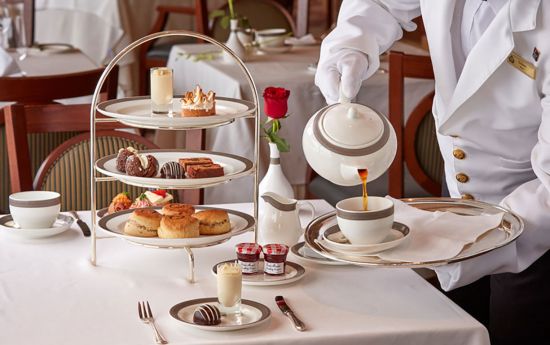
Cruise Chefs Reveal the Recipes Inspired by their Favourite Destinations
In need of some culinary escapism? Now’s the time to get creative in the kitchen
As most travel and cruise plans have been put on hold for the foreseeable future, we’ve spoken to our favourite cruise chefs and asked them to share the recipes they cook when they are in need of a little culinary escapism.
1. Wesley Cort, Norwegian Cruise Line
“My travels through Europe, and in particular, Italy, were some of my favourite food and beverage journeys, was the inspiration behind this recipe. That’s why I was so excited when we announced the launch of Onda by Scarpetta on NCL. I loved the idea of bringing the Italian food I love onto a ship in a bold and modern way. The tagliatelle bolognese we serve in Onda is as good as I have had anywhere in Italy!”

Pappardelle alla Bolognese Recipe
Serves 4 to 6
Ingredients:
- 680g/24oz fresh pappardelle pasta
- 85g/3oz grated parmesan cheese
- 28g/1oz extra virgin olive oil
- 28g/1oz butter
- 1 tbsp chopped parsley
For the bolognese sauce:
- 225g (0.5lbs) ground veal shoulder
- 115g (4oz) ground fresh Italian sausage
- 4 cloves of chopped garlic
- 1 chopped brown onion
- 225g (0.5lbs) ground celery
- 225g (0.5lbs) ground carrot
- 28g (1oz) water
- 85g (3oz) butter
- 1 bay leaf
- 115g (4oz) extra virgin olive oil
- 225g (8oz) crushed tomatoes
- 85g (3oz) tomato paste
- 225g (8oz) red wine
- 945ml chicken stock
- 28g (1oz) salt
- 0.5 tbsp ground black pepper
- 1 sprig of rosemary
- 1 sprig of thyme
Method:
- Heat a skillet and add half of the oil and the butter.
- Add the vegetables and garlic to the skillet and sauté for 5-7 minutes on medium heat.
- Add the herbs (bouquet garni) and cook for 3-4 minutes; set aside.
- In a separate large pot, heat the remaining oil.
- On a tray, lay all the meats and season lightly.
- Add to the skillet and stir occasionally in order to break up the meat, but roast it uniformly; cook until the meat is browned.
- Add the meat to the vegetables and roast until it sticks to the bottom of the pot; keep on stirring and scraping the bottom of the pot.
- Add the wine and reduce.
- Add the tomato paste, roast well, and then add the peeled, crushed plum tomatoes.
- Cook on low heat until reduced and then add the chicken stock a little at a time; gently simmer for 1 hour.
- Bring the sauce to the right consistency. Adjust seasoning.
- Boil the pappardelle pasta until al dente, approximately 2 minutes; drain.
- Add the pasta to the bolognese sauce and bring to the correct consistency, adding water if necessary. Adjust the seasoning.
- Remove from the stove and finish dish with extra virgin olive, Parmesan cheese and chopped parsley; gently stir and serve.
2. Karen Burns-Booth, Viking
“There were many amazing regional recipes that I’d never heard of until my ‘Waterways of the Tsars’ Viking cruise in 2019, which sailed from Moscow to St Petersburg. I was captivated by the array of culinary choices and discovered that it’s not all ‘boiled cabbage and pork’. Herrings under a Fur Coat is a classic Russian salad recipe and the dish is always found on a festive table, such as New Year and Christmas. I have taken a few liberties with my recipe, so the herring actually has its fur coat on the side, but you can cover your herring with the beetroot salad if you wish. Priyatnogo Appetite!”

Herrings under a Fur Coat (Shuba) Recipe
Serves 6 to 8
Ingredients:
- 6 pickled herring fillets, in oil and vinegar (chopped or halved)
- 3 large potatoes, peeled, diced into small cubes and boiled until just soft
- 2 large carrots, peeled, diced into small cubes, and boiled until just soft
- 3 large cooked beetroots, diced into small cubes (NOT pickled beetroot)
- 1 large red onion, peeled and very finely chopped
- 1/2 tsp white pepper
- 200ml mayonnaise
- 100ml sour cream, plus extra for garnish
- 4 hard-boiled eggs, cut into quarters
- Fresh dill, to garnish
- Dill pickles, to garnish
Method:
- Make sure the potatoes, carrots, beetroot and onion are all cut into the same size cubes. (Alternatively, you can grate them, but this is a messier and more time-consuming process).
- Mix the cooked potatoes, carrots, beetroot and onion together and then add the mayonnaise and sour cream. Season to taste with the white pepper, and mix well making sure you do not break or mash the vegetables.
- Arrange the herring fillets on a serving platter and spoon the beetroot mixture over the herrings and just to the side of the herrings. Garnish with the boiled eggs, fresh dill and dill pickles.
NB: For a more traditional serving idea, dice the herrings and spoon them into a serving bowl, then add the vegetables in this order: potatoes, carrots, onion, diced boiled-eggs and then the beetroot, which has been mixed with the mayonnaise and sour cream. Garnish with extra boiled eggs and fresh dill, and serve with sour cream and dill pickles on the side.
Learn more about Karen’s travel and culinary inspirations at Viking TVA.
3. Eric Lanlard, P&O Cruises
“The Caribbean is one of my favourite holiday destinations. Grenada is called the spice island because it grows so many amazing spices, as well as cacao. In this recipe, I’ve combined the island’s fabulous local ingredients. It’s a decadent exotic dessert with a crunch!”

West Indies Chocolate Tart Recipe
Serves 8
Preparation time: 20 minutes, plus chilling
Cooking time: 20 minutes
Ingredients:
- 250ml (8fl oz) single cream
- 50g (2oz) glucose syrup
- 1 vanilla pod, split
- 1 star anise
- 1 cinnamon stick
- ½ tsp freshly grated nutmeg
- 200g (7oz) dark chocolate, broken
- into pieces
- 75g (3oz) unsalted butter
- 1 x blind-baked chocolate
- Shortcrust pastry case in a 22cm (8½in) square, 3cm (1¼in) deep tart tin
For the nougatine:
- 50ml (2fl oz) milk
- 125g (4oz) unsalted butter, chopped
- 50g (2oz) glucose
- 150g (5oz) golden caster sugar
- 75g (3oz) toasted flaked almonds
- 25g (1oz) coffee beans, crushed
To decorate:
- Cinnamon sticks, star anise and cocoa powder
Method:
- Put the cream, glucose, vanilla pod and spices into a saucepan and bring to the boil. Remove from the heat and set aside to infuse for 10 minutes.
- Place the chocolate in a large bowl. Pour the infused cream through a sieve over the chocolate.
- While the mixture is warm, add the butter and stir very gently using a wooden spoon until blended – it should melt in the residual heat. Don’t over-stir. Pour the mixture into the cooked pastry case and leave to set in the refrigerator.
- Preheat the oven to 180°C (fan 160°C/350°F/gas mark 4). Line a baking sheet with silicone paper.
- To make the nougatine, put the milk, butter and glucose into a clean saucepan and heat gently until the butter has melted. Add the sugar and stir until dissolved.
- Increase the heat until you have a thick syrup, but not a caramel (106°C/222°F on a sugar thermometer, if you have one).
- Remove from the heat and stir in the flaked almonds and crushed coffee beans.
- Pour the mixture on to the prepared baking sheet and bake in the oven for 12–15 minutes, or until the nougatine has turned a nice caramel colour.
- Leave the nougatine to cool until brittle. Break into large pieces and decorate the tart by pushing pieces of nougatine into the set filling.
- Decorate further with cinnamon sticks, star anise and a generous dusting of cocoa powder.
- A rich crème anglaise flavoured with vanilla seeds and dark rum will be perfect with this indulgence.
4. Anton Egger, Seabourn
“The inspiration for my dish came from trips to visit friends in Norway where we ate ‘outdoor’ roasted local salmon. It was so simple so delicious. Then I visited Hamburg and enjoyed an old-fashioned lentil dish that was very rustic and amazingly tasty. Months later, I was visiting Bogotá, Columbia, and I ate grilled beef with aji panca chili paste and loved it. I thought this could work very well and would add a wonderful smoky, rustic flavour to the salmon, and then I added some port wine glace to give elegant richness to the dish.”

Roasted Salmon, Black Beluga Lentil Stew, Preserved Tomato Recipe
Serves 2
Ingredients:
For the lentils:
- ½ cup black beluga lentils (can substitute with green lentils)
- 3 cups chicken stock
- 2 tbsp smoked bacon, finely diced
- 1 tbsp carrots, peeled, finely diced
- 1 small onion, peeled, finely diced
- 1 glove garlic, peeled, chopped
- 1 pinch thyme, (fresh chopped or dry)
- 1 tsp olive oil
- 1 tbsp white wine vinegar
- Coarse sea salt
- fresh black pepper
For the salmon:
- x2 pieces (8oz each) salmon fillet, skin on
- 1 tablespoon olive oil
- Pinch coarse sea salt
For the preserved tomatoes:
- 1 large fresh tomato, medium-sized (or more depending on how hungry you are)
- 1 pinch thyme, (fresh chopped or dry)
- 1 drizzle olive oil
- 1 pinch coarse sea salt
- 1 pinch fresh black pepper
Method:
For the black beluga lentils:
- Check the cooking instructions on Lentil package if needed to soak in cold water overnight or not. If no overnight soaking is required, then just rinse the dry lentils in cold water and strain, then set aside.
- Cook the bacon in a medium saucepan until the fat has rendered (no extra oil needed). About 2 minutes. Add the garlic, carrots, onion, thyme and bay leave and cook for 1 more minute. Add the washed lentils and two cups of chicken stock and then simmer on low/medium heat for about 18-20 minutes.
- If needed add more chicken stock until the lentils are tender but not overcooked. Add the white wine vinegar and olive oil. Add a tbs of finely chopped parsley, season to taste with salt and fresh black pepper.
For the salmon:
- Heat the oven to 160°C/320°F.
- Place the salmon fillets (skin side down) onto a metal tray. Sprinkle (only the flesh side) with olive oil and season with coarse sea salt. Let the salmon rest in room temperature for about 15 minutes.
- In a cold non-stick pan, place the salmon (skin side down) and cook on the stovetop at medium heat, for about 5 minutes. This will result in a nice crisp skin. Transfer the salmon (skin side down) to a metal tray layered with a metal wire and cook in the oven for about 8 -10 minutes (depending on the salmon fillet thickness) at 160°C/320°F.
- Check the internal salmon temperature (using a meat temperature thermometer reader), it should read 130 degrees Fahrenheit which is medium cooked. If you don’t have a meat thermometer, the salmon should be pink, but not translucent.
- Remove the salmon fillets from the oven and let rest for 1 minute then transfer to a small tray layered with paper towel to absorb any access liquid.
For the preserved tomatoes:
- Heat up the grill to low temperature (about 140°C/284°F)
- Wash the tomato and pat dry with a paper towel. Cut in half lengthwise and remove the stem with a small paring knife. Transfer the tomatoes halves (skin side down) onto a metal tray. Sprinkle with salt and pepper, and drizzle with olive oil and sprinkle with thyme. Then transfer the tomatoes to the grill and let them slowly cook for about 20-25 min. Remove and let cool.
- Spoon some lentil stew into warmed serving dish or bowls. Place the salmon fillet (skin side up) on the lentils. Serve with a half piece of preserved tomato next to the salmon fillet.
5. Nick Oldroyd, Cunard
“There’s nothing more quintessentially British and the perfect reminder of home than a classic scone. The golden rule for making the perfect English scone is to not to overwork the dough and give efficient resting time after mixing and forming the scone dough and then again when you have rolled out and cut into the desired shape about five minutes for each stage. Always use egg yolk for glazing as this gives a delightful golden-brown crust and a great enriched flavour and end result.”

The Perfect English Scone Recipe
Recipe makes 12 scones
Ingredients:
- 500g plain flour
- 25g baking powder
- 125g diced butter
- 75g castor Sugar
- 3 eggs
- 125ml whole milk
- 60g sultanas
Method:
- Take the flour, baking powder, castor sugar and butter and rub into a fine breadcrumb texture.
- Add two of the eggs and the milk, and mix well.
- Add the sultanas and mix again.
- Knead on a lightly floured surface until smooth.
- Place the smooth side down onto a floured worktop.
- Roll out to 2cm thick, turning after each push to even the tension in the dough.
- Rest for five minutes.
- Cut the scone mix out and turn it upside down onto a paper-lined tray.
- Using the final egg, egg wash with the yolk and rest for a further 10 minutes.
- Bake at 185°C for approximately 10 minutes.
- Take them out the oven and leave to cool.
